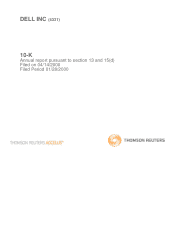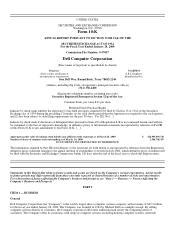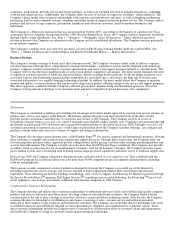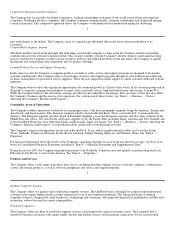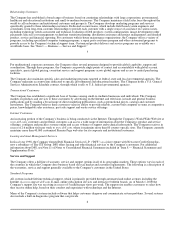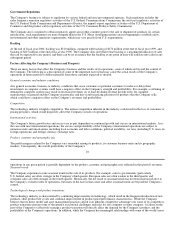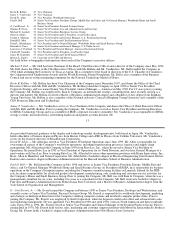Dell 1999 Annual Report Download - page 8
Download and view the complete annual report
Please find page 8 of the 1999 Dell annual report below. You can navigate through the pages in the report by either clicking on the pages listed below, or by using the keyword search tool below to find specific information within the annual report.
expenses included a $194 million charge for write-off of purchased in-process research and development resulting from the
acquisition of ConvergeNet Technologies, Inc. The amount the Company spends on research, development and engineering activities,
which the Company believes to be important to its continued success and growth, is determined as part of the annual budget process
and is based on cost-benefit analyses and revenue forecasts. The Company prioritizes activities to focus on projects that it believes
will have the greatest market acceptance and achieve the highest return on the Company's investment.
Dell Ventures
During fiscal year 2000 the Company began making equity investments in companies in order to enhance and extend the Company's
direct business model and core business initiatives. The Company makes strategic investments in other companies designed to yield
greater access to leading-edge technologies and services, expanded markets for the Company's products, insight into new markets, and
financial return. The Company generally invests in emerging technology companies with business objectives built around the Internet,
services, server and storage products and communications. During fiscal year 2000, the Company typically made mid- to late-stage
investments prior to a company's initial public offering. Subsequent to fiscal year 2000, the Company announced the expansion of this
group's activities to include investment in early-stage companies and business incubation activities. For additional information about
risk on financial instruments, see "Item 7 — Management's Discussion and Analysis of Financial Condition and Results of
Operations — Market Risk."
Patents, Trademarks and Licenses
The Company holds a portfolio of 510 U.S. patents and 431 U.S. patent applications pending, and has a number of related foreign
patents and patent applications pending. The Company's
8
U.S. patents expire in years 2005 through 2018. The inventions claimed in those patents and patent applications cover aspects of the
Company's current and possible future computer system products, manufacturing processes and related technologies. The Company is
developing a portfolio of patents that it anticipates will be of value in negotiating intellectual property rights with others in the
industry.
The Company has obtained U.S. federal trademark registration for its DELL word mark and its Dell logo mark. The Company owns
registrations for 27 of its other marks in the U.S. As of March 1, 2000, the Company had pending applications for registration of 39
other trademarks. The DELL word mark, Dell logo and other trademark and service mark registrations in the U.S. may be renewed as
long as the mark continues to be used in interstate commerce. The Company believes that establishment of the DELL mark and logo
in the U.S. is material to the Company's operations. The Company has also applied for or obtained registration of the DELL mark and
several other marks in approximately 190 other countries or jurisdictions where the Company conducts or anticipates expanding its
international business. The Company has also registered approximately 370 global domain names. In addition, the Company has
registered in excess of 200 country specific domain names. The Company has also taken steps to reserve corporate names and to form
non-operating subsidiaries in certain foreign countries where the Company anticipates expanding its international business.
The Company has entered into a variety of intellectual property licensing and cross-licensing agreements. In addition, the Company
has entered into nonexclusive licensing agreements with Microsoft Corporation for various operating system and application software.
The Company has also entered into various software licensing agreements with other companies.
From time to time, other companies and individuals assert exclusive patent, copyright, trademark or other intellectual property rights
to technologies or marks that are important to the technology industry or the Company's business. The Company evaluates each claim
relating to its products and, if appropriate, seeks a license to use the protected technology. The licensing agreements generally do not
require the licensor to assist the Company in duplicating its patented technology nor do these agreements protect the Company from
trade secret, copyright or other violations by the Company or its suppliers in developing or selling these products.
Infrastructure
Management Information Systems
The Company's management information systems enable the Company to track each unit sold from the initial sales contact, through
the manufacturing process to post-sale service and support. The systems assist the Company in tracking key information about its
customers. Using its database to assess purchasing trends, advertising effectiveness and customer and product groupings, the
Company targets marketing activities specifically to particular types of customers. This database, unique to the Company's direct
model, allows the Company to gauge customer satisfaction issues and also provides the opportunity to test new propositions in the
marketplace prior to product or service introductions.
Employees
On January 28, 2000, the Company had approximately 36,500 regular employees. Approximately 23,500 of those employees were
located in the U.S., and approximately 13,000 were located in other countries. The Company has never experienced a work stoppage
due to labor difficulties and believes that its employee relations are good.
9

